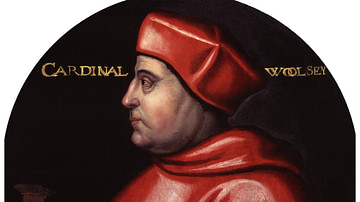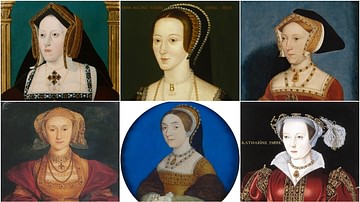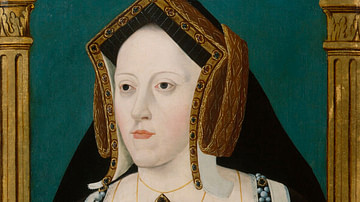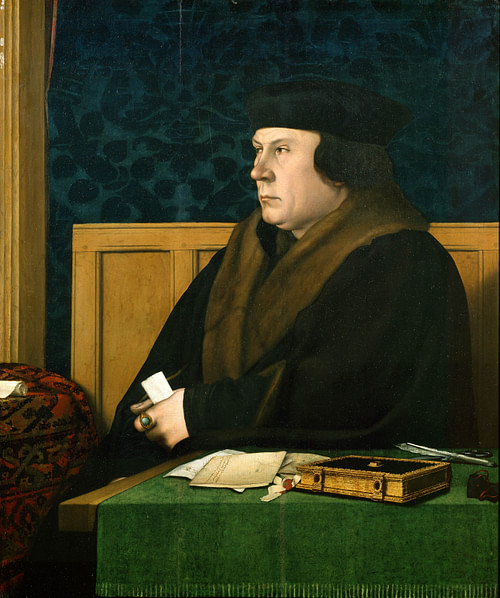
Thomas Cromwell (l. c. 1485-1540 CE) served as chief minister to Henry VIII of England (r. 1509-1547 CE) from 1532 to 1540 CE. With his king and the Archbishop of Canterbury Thomas Cranmer (in office 1533-55 CE), Cromwell masterminded the English Reformation which saw the Church in England break away from the Pope in Rome and such momentous acts as the Dissolution of the Monasteries. Gaining favour from the king for his role in successfully annulling Henry's first marriage, Cromwell is also credited with restructuring England's finances and developing the institutions of government. With powerful enemies at court and blamed for arranging an unsuitable marriage for his king to Anne of Cleves (1519-1557 CE), Cromwell was arrested on charges of treason and heresy and executed without trial in July 1540 CE.
Early Career & Rise
Thomas Cromwell was born in Putney, London, the son of a blacksmith and cloth merchant c. 1485 CE. The young Thomas earned a living as a mercenary soldier in Italy from 1503 CE and then went into business where he learnt banking in the Italian banking house led by Francesco Frescobaldi. He visited Rome in 1517 CE and then moved on to Antwerp where Cromwell worked as a merchant in the cloth trade. By 1520 CE he was back in London and making a name for himself in the financial and legal community there, where he established his own legal practice. In 1523 CE he became a Member of Parliament and already displayed an interest in Church reform. Thomas' work as a legal agent caught the attention of the Lord Chancellor, Thomas Wolsey (in office c. 1513-29 CE). Cardinal Wolsey appointed Cromwell as a legal adviser in 1524 CE and his obvious administrative talents would see him become Wolsey's most important secretary. He became a member of the King's Council in 1530 CE which eventually resulted in the apprentice even taking over the role of his master.
Thomas Cromwell was third time lucky for Henry VIII after his previous two Lord Chancellors, Wolsey and Sir Thomas More (in office 1529-32 CE) failed to make any progress in the king's 'Great Matter': to secure a divorce from his first wife Catherine of Aragon (1485-1536 CE). Wolsey could not persuade Pope Clement VII (r. 1523-1534 CE) to annul Henry's marriage and Thomas More had been against the whole idea. Wolsey died on his way to imprisonment and then trial for treason in 1529 CE, and More was imprisoned in 1534 CE. Cromwell, who had cleverly distanced himself from Wolsey when his career started to capsize, found himself sole or chief minister to Henry VIII from 1532 CE. The new man would have to step very carefully as a servant to a highly temperamental sovereign. Indeed, one of Cromwell's major tasks was to interrogate More and persuade him to accept his king as head of the Church of England instead of the Pope.

The 'Great Matter'
Still seeking a divorce from Catherine and a legitimate male heir, Henry charged Cromwell with solving the 'Great Matter' which would allow the king to marry his new favourite Anne Boleyn (c. 1501-1536 CE). To add a little pressure on the king, Anne would not sleep with Henry until they were married. Cromwell attempted to use Parliament to apply pressure on the Pope. The 1532 CE Act in Restraint of Annates limited funds the Church paid to the Papacy. Then the 1533 CE Act in Restraint of Appeals declared that the English monarch was now the highest authority on all legal matters (lay and ecclesiastical) and not the Pope.
With the Pope still against an annulment, Henry consulted with his new archbishop of Canterbury Thomas Cranmer, who advised him that the way forward was not a legal process but to consider the question of moral authority. As the Bible made no mention of Popes, a king with the divine right to rule should have the higher authority. Accordingly, Henry made the momentous decision to split the Church in England from Rome and make himself its new head. In this way, he could annul his own marriage. Thus began the English Reformation.
Archbishop Cranmer formally annulled Henry's first marriage in May 1533 CE (although Henry and Anne Boleyn had married in secret a few months earlier). This annulment and Parliament's passing of the Act of Succession (30 April 1534 CE) meant that Catherine's daughter Mary was declared illegitimate. Then the passing of the Act of Supremacy on 28 November 1534 CE meant that Henry, and all subsequent English monarchs, became head of the Church of England.

The Monasteries & Rebellion
The next scene in this momentous drama came in 1536 CE when Henry presented Parliament with a bill to abolish all monasteries in his kingdom, the Dissolution of the Monasteries. The bill was passed and the estates of the monasteries were redistributed to the Crown and Henry's supporters. The king knew exactly what he was getting as Cromwell had sent a team of inspectors to around 800 monasteries across England and Wales to determine precisely their wealth and income. The findings were listed in the comprehensive catalogue of riches known as the Valor Ecclesiasticus of 1535 CE. In addition to these purely fiscal reports, another group of Cromwell's men - mostly pro-Reformist clergy - also compiled a list of transgressions and abuses involving members of monastic institutions. This list of offences, which could be anything from petty corruption to disregarding the Oath of Supremacy, became the Comperta Monastica (aka Compendium Compertorum), and it would be a handy tool in the repression of the monasteries yet to come. The conclusion of Cromwell's endeavours was that the Church had an annual income of up to 360,000 pounds (over 150 million pounds today).
Beginning with the smaller monasteries, Cromwell ensured the whole operation went smoothly by paying off senior monks, priors, and abbots with generous pensions. With their leaders gone, all those who still resided in the closed-down institutions had to either move to another larger one or give up their calling. The Treason Act of 1534 CE, pushed through Parliament by Cromwell, even forbade people to speak out and criticise their king or his policies. Opposition was out there, though, and not limited to a handful of hardliner traditionalist amongst the clergy, as Cromwell would find out soon enough.

The king responded with an army of 8,000 men led by the Duke of Norfolk who managed to persuade the protestors to disband. As it turned out, this was remarkably easy to do as the protestors were promised reforms and full pardons. By 10 December the 'pilgrims' had evaporated. Henry might have left it at that but for a third outbreak of rebellion, unrelated to the first two but also in Yorkshire, in January 1537 CE. The king then took the opportunity to round up the leaders of the Pilgrimage of Grace and executed nearly 200 of them. Henry then pressed on with his plans and the 1539 CE Act of Parliament resulted in the closure of all remaining monasteries regardless of size or income. Those who resisted were executed. The abbots of Glastonbury, Colchester, Reading, and Woburn all resisted and all were hanged. The last monastery to close was Waltham Abbey in Essex in March 1540 CE.
The English Reformation progressed apace with Cromwell's Ten Articles of 1536 CE which rejected the Seven Sacraments of Catholicism and left but three (baptism, penance, and the Eucharist). There was the statement of the new doctrine made in The Bishop's Book, published in July 1537 CE. Cromwell produced an even stronger-worded version of The Injunctions, issued in 1538 CE. It was recommended that relics of saints were removed from churches, pilgrimages should be avoided and, in a move which has proved invaluable for local historians ever since, records be kept in every parish of all births, marriages, and deaths. Then there was the king's approval for a translation of the Bible in English in 1539 CE. It is important to remember though, that Henry was not dead set on reforming the doctrine of the Church; his commitment to traditional Catholic practices such as mass, confession, and clerical celibacy, is evidenced in the 1539 CE Act of Six Articles. The more radical elements of the Reformation would be seen during the reign of Henry's son and successor.
Other Roles & Titles
Cromwell supervised an extensive renovation of the Tower of London from 1532 CE, a project which used almost 3,000 tons of Caen stone. The fortifications were strengthened and a new jewel house built, the latter perhaps reflecting Cromwell's role as Master of the Jewels. In 1533 CE he became Master of the Rolls (and so looked after legal records for the Chancery courts). Another title Cromwell acquired was vicar-general, that is the king's vicegerent in Church affairs, a position he was awarded in January 1535 CE in order to carry out his reforms. Cromwell made full use of his powers as we have seen but he also took the opportunity to interfere on a daily basis in Church affairs (e.g. recruiting radical priests, printing radical books of devotion and creating a network of informants), so much so, Cardinal Pole described Cromwell as "an agent of Satan sent by the devil to lure King Henry to damnation!" (Turvey, 104). Such opinions did not yet jeopardise Cromwell's rise as he was made Lord Privy Seal in 1536 CE and then Earl of Essex and Lord Great Chamberlain in 1539 CE.
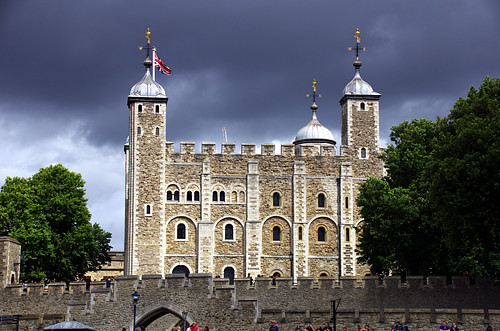
Two More Wives for the King
After all the fuss to divorce Catherine of Aragon and marry Anne Boleyn, it came as a disappointment to everyone that Henry soon sought a third wife. Henry and Anne suffered a tumultuous relationship and still no healthy son was forthcoming. The king's eye wandered once again to a lady-in-waiting at court, Jane Seymour (c. 1509-1537 CE). Cromwell took on the case against Anne, and she was accused of adultery and imprisoned in the Tower of London. Cromwell, aided by a still-strong pro-Catherine faction at court, here outdid himself. The list of charges against the queen was impressive, if mostly fictitious, and included incest with her own brother, Lord Rochford, affairs with at least four lovers, attempted murder by poison of her husband, and even witchcraft. A confession and implication of others was extracted under torture from Anne's favourite musician, one Mark Smeaton, but Anne herself denied all of the charges, as did all the other 'lovers'. Anne was found guilty as charged and executed by beheading on 19 May 1536 CE.
Within two weeks, Henry married his third wife, Jane Seymour, and she finally gave the king a son, Edward, born on 12 October 1537 CE, the future Edward VI of England (r. 1547-1553 CE). Tragically, Jane died shortly after the birth from complications and the king was distraught. Still, having only a single male heir was a risk to the Tudor Dynasty. Now Cromwell offered a fourth wife for the king, this time with diplomatic advantages. Anne of Cleves was the eldest daughter of John, Duke of the German Duchy of that name. The match was orchestrated by Cromwell as England needed Protestant allies against the Catholic superpowers of Europe: France and Spain. The betrothed met shortly after Anne arrived in England on 26 December 1539 CE, but she was to prove a disappointing late Christmas present for the king.
Anne immediately displeased the king - in her looks, personal hygiene, loud voice, and brash manners. Henry and Cromwell had been misled by an overly flattering portrait of her before they had met Anne in person. The king declared to Cromwell, "My lord, if it were not to satisfy the world and my realm, I would not do that I must do this day for none earthly thing" (Philips, 103). Henry married Anne anyway on 6 January 1540 CE at Greenwich Palace but, said to have rudely called her the 'Flanders mare', he soon changed his mind. Anne's planned coronation in February was cancelled and the pair divorced by mutual consent on 9 July 1540 CE. Anne not only escaped with her life but Henry gave her two manors, one castle and a very generous annual allowance. Cromwell did not do so well from the debacle, and he was blamed by the king for the unsuitable arrangement.

Downfall & Execution
Cromwell's grip on power was finally loosened in the summer of 1540 CE as his enemies gathered to plot against him. Most dangerous were Thomas Howard, Duke of Norfolk and Bishop Stephen Gardiner, leaders of the conservative Catholic faction that rivalled Thomas Cranmer's more radical group. The political hawks bent the ear of the king and persuaded him that Cromwell was guilty of treason and heresy. The Lord Chancellor, the 'architect of the Reformation' had seemingly gone too far in his reforms and was arrested on 10 June 1540 CE. The prisoner's protestations of innocence and several pleading letters to Henry were ignored. Never given a trial, Cromwell was executed at Tower Hill, London on 28 July 1540 CE, and unfortunately, it was a messy business as the executioner's blade was blunt. The head was displayed on a pike on London Bridge as a warning to others.
The role of Lord Chancellor or First Minister would be replaced henceforth by the Privy Council, which regained some of its former function and so high government once again involved a cabinet of ministers rather than a single all-powerful one who could monopolise the king. Although Thomas Cromwell's influence on how government worked in practice in England has been exaggerated by some historians and claims that he 'revolutionised' politics have now been discredited, he did perhaps see potential where others previously had not. As the historian J. Morrill here summarises:
Cromwell's wide-ranging vision comprehended additional possibilities for parliamentary action…He saw that the state's power could be used to resolve or at least ameliorate some of the problems generated by the contemporary population explosion - poverty, unemployment, and social disorder. His tentative moves in this direction, added to the religious Acts, produced an unprecedented volume of parliamentary enactments, inaugurating an age in which the scope of legislation and of members' activity in Parliament would increase rapidly. (318)
